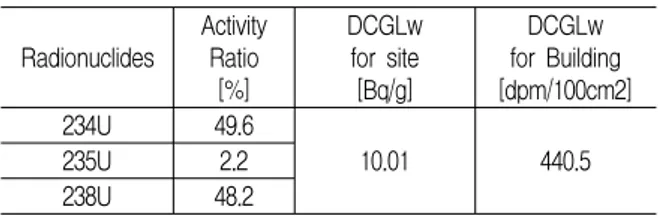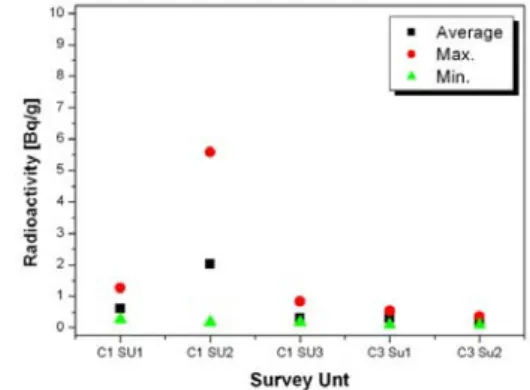2011년도 추계학술발표회 논문요약집 대한방사선방어학회
242_http://www.karp.or.kr
Implementation of the MARSSIM to Evaluate the Final
Status After Decommissioning Uranium Conversion Plant
Sang Bum Hong ․ Doo Seoung Hwang ․ Ki Won Lee ․ Jei Kwon Moon Korea Atomic Energy Research Institute
E-mail: sbhong@kaeri.re.kr
Keyword : Uranium Conversion Plant, Decommissioning, DCGL, MARSSIM, RESRAD, RESRAD-Build
Introduction
The decommissioning project of Uranium Conversion Plant was launched in 2001 and completed at the first half of 2011. The final stage of decommissioning process was the release of a site and building from regulatory control. KAERI carried out a final status survey based on the guidance provided in the MARSSIM (Multi-Agency Radiation Survey and Site Investigation Manual). The Uranium Conversion Plant was used to manufacture UO2 powder for CANDU fuel, the plant was contaminated only natural uranium. In this study, plans for the final status survey and release criteria for a site were established by applying the MARSSIM procedures. The survey design for the final status survey of the UCP site and buildings was carried out based on the statistical test of the results form scoping and characterization survey. The site and buildings were classified based on the potential contamination by using measured and calculated results. The results of the final status survey were satisfied the release criteria based on the measured data from a site and building.
Material and Methods
The fundamental objective of the final stage of the assessment of the residual contamination was to demonstrate a satisfactory residual contamination level in accordance with the established release criteria. The release dose criteria recommended by the IAEA were between the dose constraint (300 μSv/y; a portion of dose limit) and a trivial dose range (~10 μSv/y). The release criteria were not established in Korea, but KAERI proposed the release criteria as 100 μSv/y for considering the future unrestricted use of the site and the urbanization of the surrounding area. The regulatory body also recommended the same value of criteria. The site specific DCGL (Derived Concentration Guideline Level) was calculated for the UCP site and buildings by using RESRAD and RESRAD-Build codes separately. The calculated results of the site and building are shown in Table 1. Radionuclides Activity Ratio [%] DCGLw for site [Bq/g] DCGLw for Building [dpm/100cm2] 234U 49.6 10.01 440.5 235U 2.2 238U 48.2
2011년도 추계학술발표회 논문요약집 대한방사선방어학회
제6분과(측정 및 분석)_ 243 The purpose of the final status survey was to
demonstrate that the residual radioactivity in each survey unit would satisfy the release criteria. The final radiological condition of the site and building must satisfy the DCGL. In order to reach the final status survey, it was very useful to follow a radiation survey and site investigation process suggested in MARSSIM. The site investigation process includes Historical Site Assessment, Scoping Survey and Characterization Survey. For the MARSSIM survey design, the contaminants and their levels were identified, and it was determined whether the radionuclides of concern existed in the background. The site was divided into Class 1, Class 2, and Class 3 according to the contamination potential. The site and building was contaminated with natural uranium, the WRS test was applied for survey design because of the contamination in background. The statistical parameters for a survey design at the Class 1 area are shown in Table 2. The number and location of the sampling points used to demonstrate compliance with the release criteria.
Item DCGL for site [Bq/g] DCGL for Building [dpm/100cm2] LBGR 5.0 2.09 Relative Shift 3.66 3.25 Type Ⅰ, Ⅱ error 0.05 0.05 Survey desing (samples/survey unit) 9 10
Table 2. Statistical Parameter of survey design.
The required sample size was 9 samples in site and 10 samples in building in each survey unit of the Class 1 area. The number of data sets necessary to satisfy these non-parametric tests was determined on the basis of the DCGL of contaminants. The MARSSIM also requires a reasonable level of assurance that any hot spots
that could have a significantly higher radioactivity than regulatory limits should not be missed during the final status survey . The sampling locations in each survey unit ware established by using a random start triangular grid pattern because the site contains many facilities. The soil samples were measured for their radioactivity by using the HPGe detector.
Result and Conclusion
The summarized final status survey results are given in Figure 1 shows detail residual contamination level in Class 1. The results of the final status survey are sufficiently lower than the release criteria.
Figure 1. Final status survey results in Class 1 area
The MARSSIM procedures were proved to be flexible, scientifically rigorous and cost effective for final status survey of decommissioning site and building. For the effective plan for the final status survey of the UCP site and its implementation, KAERI and its the regulation body are continuously discussing way to ensure the validation of the final status survey.

